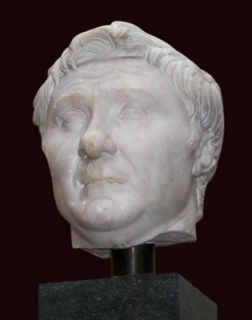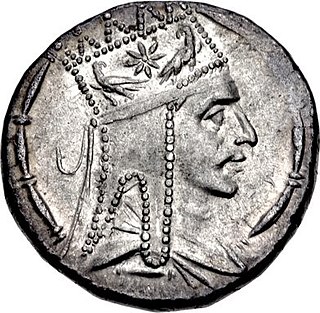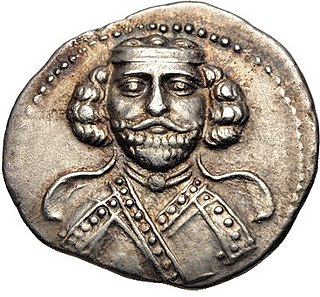Related Research Articles

Gnaeus Pompeius Magnus, known in English as Pompey or Pompey the Great, was a leading Roman general and statesman. He played a significant role in the transformation of Rome from republic to empire. He was a student of Roman general Sulla as well as the political ally of Julius Caesar.

The 1st century BC, also known as the last century BC and the last century BCE, started on the first day of 100 BC and ended on the last day of 1 BC. The AD/BC notation does not use a year zero; however, astronomical year numbering does use a zero, as well as a minus sign, so "2 BC" is equal to "year –1". 1st century AD follows.
This article concerns the period 69 BC – 60 BC.
This article concerns the period 79 BC – 70 BC.

This article concerns the period 109 BC – 100 BC.
Year 63 BC was a year of the pre-Julian Roman calendar. At the time it was known as the Year of the Consulship of Cicero and Hybrida. The denomination 63 BC for this year has been used since the early medieval period, when the Anno Domini calendar era became the prevalent method in Europe for naming years.

Tigranes II, more commonly known as Tigranes the Great was King of Armenia under whom the country became, for a short time, the strongest state to Rome's east. He was a member of the Artaxiad Royal House. Under his reign, the Armenian kingdom expanded beyond its traditional boundaries, allowing Tigranes to claim the title Great King, and involving Armenia in many battles against opponents such as the Parthian and Seleucid empires, and the Roman Republic.

Lucius Licinius Lucullus was a Roman general and statesman, closely connected with Lucius Cornelius Sulla. In the culmination of over twenty years of almost continuous military and government service, he became the conqueror of the eastern kingdoms in the course of the Third Mithridatic War, exhibiting extraordinary generalship in diverse situations, most famously during the Siege of Cyzicus in 73–72 BC, and at the Battle of Tigranocerta in Armenian Arzanene in 69 BC. His command style received unusually favourable attention from ancient military experts, and his campaigns appear to have been studied as examples of skillful generalship.

Phraates III, was King of Kings of the Parthian Empire from 69 BC to 57 BC. He was the son and successor of Sinatruces.

The Third Mithridatic War, the last and longest of the three Mithridatic Wars, was fought between Mithridates VI of Pontus and the Roman Republic. Both sides were joined by a great number of allies dragging the entire east of the Mediterranean and large parts of Asia into the war. The conflict ended in defeat for Mithridates, ending the Pontic Kingdom, ending the Seleucid Empire, and also resulting in the Kingdom of Armenia becoming an allied client state of Rome.
Gaius Manilius was a Roman tribune of the plebs in 66 BC. He is primarily known for his Lex Manilia, the bill which gave Pompey the Great command of the war against Mithridates.
The Battle of the Lycus was fought in 66 BC between a Roman Republican army under the command of Gnaeus Pompeius and the forces of Mithridates VI of Pontus. The Romans easily won the battle with few losses. Mithridates fled to Crimea and committed suicide in 63 BC, finally ending the Third Mithridatic War.

The Battle of Artaxata was fought near the Arsanias River in 68 BC between an army of the Roman Republic and the army of the Kingdom of Armenia. The Romans were led by proconsul Lucius Licinius Lucullus, while the Armenians were led by Tigranes II of Armenia, who was sheltering Mithridates VI of Pontus. The battle was part of the Third Mithridatic War, and was a Roman victory.
Cleopatra of Pontus was a Pontian princess and a queen consort of Armenia.
The lex Manilia was a Roman law passed in 66 BC granting Pompey the military command in the East against Mithridates VI of Pontus.
Lucius Volcatius Tullus was a Roman politician who became consul in 66 BC alongside Manius Aemilius Lepidus.
Quintus Caecilius Metellus Celer, a member of the powerful Caecilius Metellus family who were at their zenith during Celer's lifetime. A son of Quintus Caecilius Metellus Nepos, or, according to some, the son of tribune Quintus Caecilius Metellus Celer while the latter is the son of Quintus Caecilius Metellus Nepos, was an ancient Roman statesman and general during the First Century BC. He became consul in 60 BC and previously he held the offices of praetor and augur.
Quintus Caecilius Metellus Nepos was a son of Quintus Caecilius Metellus Nepos. He was a tribune of the plebs in 62 BC, a praetor in 60 BC, a consul in 57 BC and the governor of Hispania Citerior in 56 BC.

Cappadocia was a province of the Roman Empire in Anatolia, with its capital at Caesarea. It was established in 17 AD by the Emperor Tiberius, following the death of Cappadocia's last king, Archelaus.

Bithynia and Pontus was the name of a province of the Roman Empire on the Black Sea coast of Anatolia. It was formed during the late Roman Republic by the amalgamation of the former kingdoms of Bithynia and Pontus. The amalgamation was part of a wider conquest of Anatolia and its reduction to Roman provinces.
References
- Moore, Katrina (2017). "Octavia Minor and the Transition from Republic to Empire" (PDF). Clemson University.